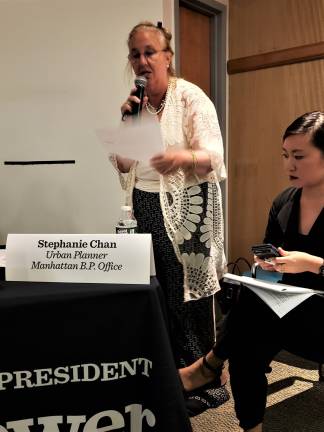locals give thumbs down to flood plans

Angry Lower East Side residents expressed their displeasure last week with the city’s plan to shutter East River Park for three years, from March 2020 to the summer of 2023, as part of the East Side Coastal Resiliency project, which will storm proof the park from Montgomery Street to 13th Street.
Borough President Gale Brewer held a public hearing on the project at Mt. Sinai Beth Israel on July 17th. The auditorium at the hospital was jam packed. Some of those in attendance draped caution tape reading “Tree Protection area.” around their necks,
Jamie Torres-Springer, the first deputy commissioner at the city Department of Design and Construction, and Alyssa Cobb-Konon, the deputy commissioner for Planning and Development at NYC Parks, presented the plan.
They did not receive a warm welcome.
More than two dozen people testified against the project, asking why the park had to be closed for so long and expressing concern about a range of issues.
A Change in Plans“We feel like we haven’t been heard,” said an emotional Pat Arnow, an LES resident. “There’s going to be environmental damage and physical and mental health consequences for our community. We’ve been demanding a new plan or to revisit the plan the community helped create that was abandoned for a much more expensive, destructive plan we have now.”
Many residents, including Arnow were infuriated with the fact that there is only a two-week extension on the Draft Environmental Impact Statement (DEIS) comment period. They wanted 60 days. However, the City Planning Commission will vote July 31 and a final vote will take place in September before the City Council.
East Side Coastal Resiliency is a plan to protect the lower Manhattan communities along the East River that were most affected by Hurricane Sandy from the effects of future storms and sea level rise. The 2.4-mile-long project will install a continuous flood protection system from Montgomery Street north to East 25th Street. Flood protection would consist of a combination of floodwalls and deployable flood gates, raised landscapes and other structures, each individually tailored to the specific site in which they will be constructed.
The city’s original plan called for flood barriers and beams along the FDR. But in September 2018, city planners came up with a newer version that could be implemented quicker, raise the park eight feet using a landfill, install flood gates and fix the drainage system.
This did not sit well with residents, however.
Questions and Complaints Al Morales, 69, has been maintaining baseball fields for many years. He could not fathom as to how or why the city would need to close the park for three years.
“It [the work] needs to be done in sections,” Morales said. “You cannot close this park down.”
Other issues raised by residents were the need for an independent review of the revised plan and how it will affect the environment. “We really need an independent review of this project,” said Naomi Shore. “We need to know if this plan is worth it. We need to see if this plan will create climate justice in the long term. Why are we spending $1.5 billion on a project that does not even in any minimal way address the causes of climate change?”
The verbal attacks on Torres-Springer and Cobb-Konon continued. Tommy Loeb said the new plan “blindsided the community” and really isn’t looking out for the residents. He asked the officials how the new landfill will settle and how long there will be a pile of dirt. He supports being prepared for another super storm, but there has to be a better way, he stressed. “We have no confidence in you (Torres-Springer and Cobb-Konon),” he said.
Elected officials were also on hand. State Senator Brad Hoylman said the project has many holes in it and that he wants a third party to review it. Furthermore, the senator noted, it may end up in a lawsuit. “We have a lot of questions and not a lot of answers,” Hoylman said. “Sadly, we don’t have a lot of confidence that this project is going to go as well as our colleagues in the city say it will.”
Natalie Dorset, who runs often in the park, asked Cobb-Konon and Torres-Springer if they had visited the park and seen how many go there daily. She asked if they had ever been there at 5 a.m. when people are running or fishing, or during the afternoon, when there are barbecues and birthday parties. “Get out there and see how the park is actually used,” she said. “Don’t just sit there in your air conditioned offices.”